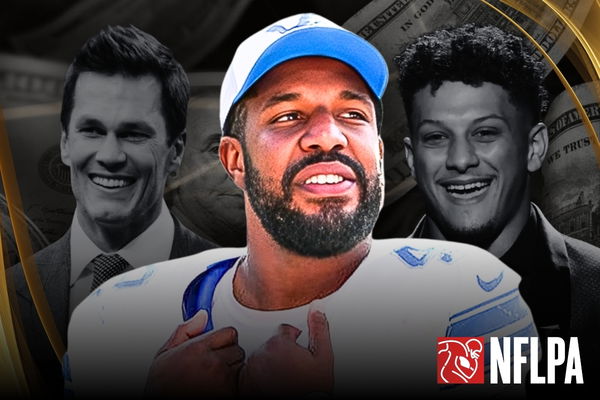

When Detroit Lions linebacker Jalen Reeves-Maybin became the National Football League Players Association (NFLPA) President in 2024, no one expected much from him. But for the athlete, business skills came naturally. At the organization’s helm since March 2024, his first year ended with a historic feat, ending 2024 by becoming a billion-dollar organization.
From charter flights, stronger contract deals, and legal fees to help them ease back into regular life post-football, the NFLPA ensures players don’t have to struggle much. Panthers tight end had first-hand externship experience with Under Armour in 2018 and FOX Sports in 2019. Here’s how the second-oldest sports union in the country became the most valued one.
ADVERTISEMENT
Article continues below this ad
NFLPA’s Financial Growth: From Struggles to a Billion-Dollar Union
After the formation of the National Football League in 1920, players faced financial issues, often complaining they were underpaid. Players from 11 teams, including Baltimore Colts‘ Don Shula and Lions’ Joe Schmidt, supported a union with the Chicago Bears being the only team that didn’t join. But in the last 6 decades, the NFLPA became the players’ forefront by educating them on nuances of the league and life outside of that. Here’s an overview of how the NFLPA grew financially over the years.
The journey can be divided into two broader categories: pre-2011 Collective Bargaining Agreements (CBAs) and post-that year.
2011 – Transition from financial struggles to billion-dollar assets
“As we have always said, the only way to avoid a fight is to be prepared for one,” said Interim Executive Director Richard Berthelsen in 2007, referring to the rising legal fees in the sport. Then, the union revealed they had earned $181 million in the decade ending in March 2008. According to Sports Business Journal, their assets almost doubled in 5 years between 2006 and 2010.

via Imago
NFLPA Assets pre-2011
In 2011, the league owners agreed to a 10-year CBA, the first for a decade, understanding the players’ strikes cost them more. They also understood the growing advent of the internet. So, NFLPA started growing rich in assets post 2011 CBA. In 2021, the new CBA was signed until 2030. Here’s an analysis of NFLPA’s assets for the decade before 2024 via ProPublica.

via Imago
NFLPA Assets post 2014
The 2024-2025 tax filing until February 2025 revealed the NFLPA crossed $1 billion in its assets. That’s the first time in history. In the last few years, the union has made very sound financial decisions. A few of them are listed here.
How did the NFLPA cross the billion-dollar mark?
The NFLPA earns money through different sources, by investing, licensing deals, and player dues.
- Investments – According to the New York firm, CB Insights, the NFLPA has invested in 9 firms worth $689.6 million. It includes Whoop, Nifty Games, and Infinite Athlete. In January, the union invested $30 million in Miach Orthopaedics, based in Boston.
- Licensing – This brings in a major share as the NFLPA holds exclusive rights to use the names, images, and likenesses of 2000+ league players. In 2023, the union signed a new deal with Fanatics, after breaking their deal with Panini. It allowed them to pay the active players at least $32,000 in 2024.
- Player dues – In 2020, the average yearly annual membership dues for NFLPA was $31,000.
The average NFL career is less than 5 years. Yet the NFLPA keeps organizing programs to help the players. Former running back Mack Brown is one of them. He only played for 5 years in the league, but got a dual MBA in real estate development and finance from Liberty University, via The Trust scholarship. He now runs an LLP in real estate and the Built Tough Foundation for the youth in his community.
Other than those we listed above, they keep trying to find other options to make money. Yet, we need to give credit where it’s due.
How a Detroit Lions Backup Became the Face of NFLPA’s Billion-Dollar Era?
While playing football in high school, Jalen Reeves-Maybin played baseball. But football was his first passion. However, he knew he wouldn’t become a dominant player as a quarterback. So, he became a special team player. But the uncertainty of a football career pushed him to learn what most players ignore. The finances of the NFL!
In 2021, Reeves-Maybin took the first step as Detroit’s first alternate. He wasn’t much into it, but after seeing fellow players, he got motivated and once revealed, “I saw how players struggled with financial planning, health care, and post-career transitions, and I knew we needed leadership that fought for us all.”
2022 was the first step in his rise. He was voted to the union’s Executive Committee. That’s when he got the taste of what it feels like. Managing player complaints, owners’ qualms, and how things worked enhances his leadership roles.
In his own words, the experience gave him clarity and a deeper understanding of the union’s vision: “So I’ve kind of seen everything at a deeper level. And watching our previous president, J. C. Tretter, see how he kind of operates and communicates with the guys. I felt like it was time for me to take the next step.”
According to the NFLPA constitution, the players choose their new president for 2 years. In 2024, they elected the Lions backup linebacker, Jalen Reeves-Maybin. The Lions drafted him in the 4th round (124th overall) of the 2017 NFL Draft. In 2024, he signed a 2-year $7.5 million contract extension with them.
However, while he mostly played as a backup player, he educated himself on other aspects of the game. “It will be my mission to continue to serve and unify our membership and I look forward to inspiring more players to use their voice in advocating for the union and our game,” he said when chosen as president. The years of experience helped him make those changes that drove them to a billion-dollar mark.
Leverage at the Table: How Financial Strength Translates to Player Empowerment?
To understand how the NFLPA has evolved over the years, let’s take a look at its rich history.
- July 14, 1968 – First Collective Bargaining Agreement signed, Owners agree to give $1.5 million from league revenue for pension, minimum salaries of $9,000 for rookies, $10,000 for veterans, and $50 per exhibition game
- 1970 – NFLPA becomes certified union, 4-year CBA signed with increased pensions
- 1977 – 5-year CBA signed
- 1982 – Season marred by a 57-day strike, the season shortened from 16 games to 9 games, New CBA signed, NFLPA receives players’ contract copies for the first time
- 1989 – NFLPA decertifies itself as a players’ union as players file independent lawsuits with disputes over free agency, salary cap formula accepted by all 32 teams
- 1993 – New CBA signed, Minimum salaries of $12,500 for rookies and $13,000 for veterans, gets extended 5 times till 2010
With the development of technology, the game became more popular. So, the players had more demands on revenue sharing. The Internet was the game-changer.
- July 30, 2011 – New CBA signed till 2020
- 2020 – New CBA signed until 2030, minimum salaries of $795,000 for rookies
One thing that has eased out by signing longer tenure CBAs is the strikes. In 2020 CBA, they signed a new drug policy that removed suspension for marijuana, even raising the threshold from 35 to 150 nanograms of THC.
Here’s how the league revenue has increased over the years.

via Imago
NFLPA Revenue increase
As the assets have increased, the NFLPA has acquired power in CBA negotiations. It showed up in 2020 when the owners wanted more games (17 instead of 16). Hence, the NFLPA also successfully increased revenue sharing.
For every major increase in TV deals, players now secure a bigger slice of the revenue pie, ensuring their salaries grow alongside the league’s booming profits. The minimum they get is 48% of the league revenue. But it increases to 48.5% revenue if the league’s TV revenues increase by 60% and 48.8% if the league’s TV revenues increase by 120% or more.
According to ESPN’s Adam Schefter, 60% of the players play on a minimum salary. In the 2020 CBA, the minimum salary for a player with 1-year experience increased from $510,000 to $610,000 in 2020. It would increase to $1.065 million in 2030.
Back in the days when the NFLPA assets were limited in capacity, there used to be concerns about legal battles and other issues. However, the increase in players’ revenue sharing also increased the association’s capacity to handle their programs for the welfare of the players.
A Case Study – Salary Caps
The NFL salary cap is a crucial mechanism designed to maintain competitive balance by limiting the total amount each team can spend on player salaries. NFLPA has been successful in managing the salary caps so that the owners can’t cut back on the compensation of other players to offer excess money to one athlete. Over the past three decades, the salary cap has seen significant growth, reflecting the league’s increasing revenues. Here’s a detailed look at its evolution:
Historical Salary Cap Figures:
- 1994: The salary cap was introduced at approximately $34.6 million per team.
- 2000: The cap increased to around $62.2 million.
- 2010: The NFL operated without a salary cap due to the expiration of the previous Collective Bargaining Agreement (CBA).
- 2011: The cap was reinstated at $120 million following a new CBA.
- 2020: The cap reached $198.2 million, with an additional $40 million per team allocated for player benefits.
- 2021: Due to revenue shortfalls from the COVID-19 pandemic, the cap decreased to $182.5 million.
- 2022: The cap rebounded to $208.2 million.
- 2023: It further increased to $224.8 million.
- 2024: The cap was set at $255.4 million, marking a record 13.6% increase from the previous year.
Impact on Player Compensation: The rising salary cap has enabled teams to offer more lucrative contracts, particularly to star players. For instance, quarterback contracts have escalated significantly, with some players securing deals averaging over $50 million annually. This upward trend in player salaries is closely tied to the increasing cap, which allows teams greater financial flexibility.

via Imago
Salary Cap Rise in NFL
Balancing Team Rosters: While higher caps permit substantial contracts for marquee players, teams must strategically manage their payroll to maintain a balanced roster. Overspending on a few individuals can limit resources available for other positions, potentially affecting overall team performance. Therefore, prudent salary cap management is essential to ensure depth and competitiveness across all roster spots.
The NFL salary cap’s evolution mirrors the league’s financial growth and plays a pivotal role in shaping team strategies and player compensation. Effective management of the cap is crucial for teams aiming to build competitive and balanced rosters in the dynamic landscape of professional football. That’s a major part of NFLPA, but not the only one.
Investing in Players: Career Growth, Wellness, and Retirement
A great example…
One thing that Jalen Reeves-Maybin must be credited for is capturing enormous opportunities at the right moment. The last moment when a team came close to a 3-peat was Tom Brady’s Patriots in 2005. This year, the Chiefs stand on the verge of a 3-peat. So, the linebacker understood they needed to cash in. He took action. It may have forced them to abandon their deal with Panini, paying them $7 million to move their deal with the card maker Fanatics, ahead by activating it in 2024, instead of originally scheduled 2026.
Another NFL player benefitted immensely from the NFLPA’s initiatives. The former linebacker didn’t just plan for retirement—he built a real estate empire with 22 investments, proving how NFLPA’s financial literacy programs can create second careers.
According to Sportico, in 2023, Patrick Mahomes earned $3.6 million in group licensing and marketing income. Taylor Swift’s boyfriend, Travis Kelce, also earned $2.4 million. But it didn’t stop at the active players. Peyton Manning got $2.1 million, while Rob Gronkowski earned $1.9 million.
NFLPA runs programs for help and welfare
There is one question that is commonly attributed to almost all the sportspersons, not only the footballers. Why do they always end up poor after earning millions in their career? The answer is obvious. A lack of financial acumen! NFLPA tries to tackle it every year with renewed strength. Here’s how.
- Continuing Education Program – “The big thing is, whether you play in this league for two, three or four years, take advantage of the platform and these resources from the union, “said NO Saints Linebacker Andrew Dowell. He used this program to study the Penn State World Campus’s Masters in Corporate Innovation and Entrepreneurship program through the Smeal College of Business.
- Helping the athletes follow their passion – The NFLPA helps conduct workshops where the players can talk directly to people from the field they are interested in other than football. Former linebacker Devon Kennard didn’t just plan for retirement—he built a real estate empire with 22 investments, proving how NFLPA’s financial literacy programs can create second careers.
- Teaching wealth management – In 2002, the NFLPA began the Financial Registration Program for retired or active players. The union has tied up with various wealth managers, including Morgan Stanley, to help the players understand their future needs and plans to set up their money flow.
With the 2020 CBA, the NFLPA just secured $2 billion for NFL player benefits. Most of them go to the welfare of retired players. The retired players get $11,500 per month under disability plan. The union also has a pension plan that pays pension for the vested players according to the age and seasons they have played in.
| Credited Seasons | Benefit Credit |
| 1998-2011 | $470 |
| 2012-2014 | $560 |
| 2015-2017 | $660 |
| 2018-2020 | $760 |
The NFLPA also ties with various medical institutions to help with injuries of retired players. In 2018, the union organized a mental health session with Cigna to help players struggling with their mental health. That gives a boost to the players.
How NFLPA Helps Players in Disputes?
With billion-dollar assets under management, the union has also made sure to cover almost all the financial aspects of the sport. It is often reflected in the fines and legal process when it steps up to help players avoid any major spending.
Legal fees process of the NFLPA
Every year, the league also spends millions of dollars on legal fees, ensuring players don’t have to strain their pockets fighting the billion-dollar owners. Players are not charged for such cases. Instead, the royalties collected from the NFL paraphernalia are used to pay the lawyers or firms. The players can approach the union with a request to help. Or they can automatically represent the athlete in a court of law.
In 2016, the NFL suspended Tom Brady for 4 games for the Deflategate, accusing him of deliberately deflating the ball in the AFC championship game against the Colts. It was a big blot. The GOAT filed a lawsuit but lost. That’s when the NFLPA pressed on.
By appointing the appellate advocate Ted Olson and his firm, Gibson, Dunn & Crutcher, on the case, the union stood strong behind him. They spent around $3.5 million, finally getting success as the court overturned the 4-game suspension.
NFLPA helps players deal with fines
When a player is fined, 50% of that money isn’t pocketed by the league—it goes straight to help retired players, proving that the NFLPA’s influence extends beyond the field. In 2020 CBA, it outlined all procedures for the fines, the appeal process, and where the money goes.
50% of all fines go to the Players Assistance Trust, which enables NFLPA with extra money to help retired players. Also, if they want to finalize an amount for more than $50,000, the league must consult with NFLPA executive director Lloyd Howell.
The union, along with the player, receives a copy of the fine with the video. The player himself can appeal or authorize the NFLPA to appeal for the fine if not satisfied with the fine.
How it works?
Previous NFLPA President JC Tretter revealed in 2023 that a player was fined $87,000 for the illegal use of a helmet. But when they appealed, the judge found that the league didn’t answer the coach’s request for the correct technique and rescinded the entire fine.
A Billion-Dollar Future: What’s Next for NFLPA?
The current 2020 CBA is under effect until 2031, but the union is already working on the changing scenario. There are 3 main issues in front of the NFLPA.
Off-season changes
In May 2024, the union revealed working on an overhaul of the off-season schedule. It wanted the NFL teams to eliminate the workout programs in April and OTAs in May. But the union proposed a longer stretch for recovery, with the players reporting in late June or early July.
It also means the union would have more time to educate players about new programs or the current rules, helping them plan their lives in and out of the game.
In-Season changes
One of the biggest rumors is about an 18-game season. The union has remained silent on it, but the players have opposed it, stating it would cause more injuries. President Jalen Reeves-Maybin downplayed this in March 2024, saying it would be discussed in the next CBA agreement.

via Imago
Injury rate comparison on artificial and natural surfaces
The bigger issue is the natural grass surface in place of turfs. But the financial plans for this haven’t been finalized yet. The league, overall, has also not agreed on this.
ADVERTISEMENT
Article continues below this ad
Broadcasting and other revenue-sharing changes
The recent changes, like streaming giants like Netflix entering the NFL arena, and legalized gambling, have forced the union to keep an eye out for changes.
Every year, the NFLPA organizes a Pith Day where startups show their business idea. If the union finds it good, then it also invests. WHOOP, Healium, and Round21 are a few companies that benefitted from the union’s investments.
ADVERTISEMENT
Article continues below this ad
NFLPA’s Significance and Increasing Role in Players’ well being
With growing money in the game, the NFLPA has a bigger role to play. However, the owners also want to push the players to play more games. They also need to curb the dissent. The 2020 CBA was passed with a 1,019 to 959 majority vote.
The expenditure to take care of the retired players is also increasing. And the pool is getting bigger. Maybe the next target is to touch the 2-billion mark. With billions under management and strong leadership at the helm, the NFLPA is no longer just a union—it’s a force shaping the future of football itself.
ADVERTISEMENT
ADVERTISEMENT
ADVERTISEMENT
ADVERTISEMENT
